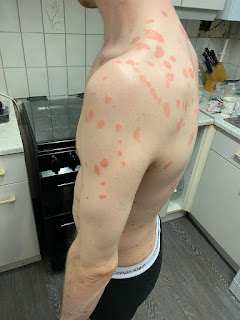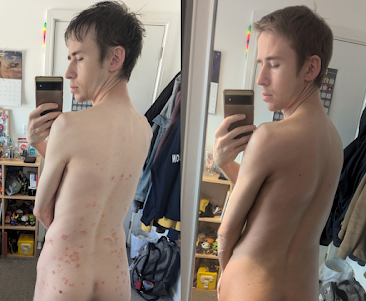“You’ve been waiting a while”
“18 months”
Following a referral that was made on Monday 7th March 2022, I finally had my phototherapy consultation at Salford Royal Hospital on Monday 4th September 2023. And guess what? I didn’t need it anymore!
During my era of desperation- at the beginning of what was initially a 60-week waiting list before being delayed twice- I emailed local skin clinics and beauty salons that offered LED Light Therapy. I had read about their benefits and hoped it would be an alternative to that hellishly-long NHS waiting time.
However, I was told that it would not be suitable, because my psoriasis coverage was too widespread. The best offer I received was sessions that would deal with my face only:
“The LED light therapy can help with the psoriasis on the face, but we don’t have a machine large enough for the body as well.”
It was distressing to know that I would only be receiving proper treatment in over a year’s time; to pay for it privately would have set me back thousands of pounds. This encouraged me to take care of my guttate psoriasis alone.
What is phototherapy, though? Also known as just light therapy, it is a procedure where doses of ultraviolet (UV) rays are projected onto the skin in order to slow its growth. Afterall, psoriasis marks occur where new skin cells are being produced too quickly. This is done so at regular intervals, meaning several trips to the hospital over a period of 6-8 weeks.
This is different to the aforementioned LED Light
Therapy, which doesn’t use UV rays (light in different wavelengths i.e. red and
blue are applied instead). Too much phototherapy can increase the risk of skin
cancer due to repeated ultraviolet light exposure- the same reason why staying
in the sun for too long is dangerous.
Another type of phototherapy- or, photochemotherapy- is PUVA. It gets its name from Psoralen (the 'P') that is ingested/applied topically to make the skin more sensitive to the Ultraviolet A (the 'UVA') light that is administered. PUVA is immunosuppressive and therefore associated with an increased risk of skin cancer.
Before I go on to the appointment, it’s important to know that using a tanning bed is not the same as phototherapy. The UV wavelengths used in the latter are very specific- and different to those emitted in sunbeds, which are actually more harmful. Furthermore, the beams of light in phototherapy are highly focused, measured and directed onto psoriasis patches, unlike a sunbed’s all-over exposure. If you know anyone using indoor tanning to try and treat their psoriasis, please tell them to stop.
So, visiting a dermatology department once more, I was more or less told things that I had already found out for myself long ago. My progress pictures were looked at, and it was agreed that strep throat was the likely trigger.
I was informed that a flare-up can cause stress, which can then aggravate it further (elementary!) before being told that I definitely don’t need light therapy. I was reminded of the increased risk of skin cancer associated with it.
When asked if I still used steroid creams, I spoke about the homemade body butter, Colloidal Oat Cream and Skin Salvation they have been replaced by. I was assured that my appointment would be kept “open” for another 12 months- so if I experience any more guttate, I don’t have to start again at the GP.
I showed my remaining marks. No new knowledge or treatments
were bestowed on me…but my t-shirt was complimented twice.
I do wish I could tell early 2022 Scot that everything was going to be alright. It feels wonderful to have healed myself before requiring phototherapy...
*
...but then 2024 Scot faced a flare-up. Out of my many new research strands, one took me down the infrared saunas path.
To be clear, the lack of scientific evidence and studies means they can only be considered a complementary therapy. Online articles and webpages promoting their alleged benefits are predominantly written by sauna businesses and spas offering this service.
No sources were impartial or professional enough for me to link to them in this blog. However, I took in information from over 20 of them to understand how these saunas operate:
Infrared heaters emit an invisible, infrared light which is absorbed by the skin, causing the body to heat up from the inside. Therefore, the body itself is heated, rather than the surrounding air like in a traditional sauna.
While most of the sites proceed to talk about toxins being released through the sweat, it is instead understood that the process of sweating is to simply cool ourselves down. They also claim that the sweat shed in an infrared sauna contains less water and more toxins compared to a traditional sauna- but, unsurprisingly, other sources dispute this.
The majority view of the sites is that, through raising the body’s core temperature, an “artificial fever” is induced, prompting the immune system to act. This improves the immune response and, in turn, eases inflammation (as does the increased blood circulation). I couldn’t find any sources debunking this theory, and ‘temperature as a therapy’ appears to be a reasonable proposal.
Another benefit put forward is that infrared radiation improves collagen production. This may be true: collagen- a protein needed for supporting and strengthening the skin- is produced in fibroblasts. These cells are said to be stimulated by the radiation to make more collagen. Again, I searched for articles contradicting this, but I did not come across any…but that’s not to say it’s bona fide!
The claim that it stimulates shedding of overgrown skin, leading to a visual improvement of lesions, is explained by the heat softening plaques and promoting their removal. Warm water and moisturisers tend to be associated with the ability to soften scales rather than ‘dry’ heat, so I’m not all that convinced by this.
I don’t contest that infrared saunas reduce stress by promoting homeostasis: I’ve only been in traditional saunas two or three times, but they do provide a relaxing experience.
While we should be cautious of biased companies offering rose-tinted
perspectives of infrared saunas, they may not need to be disregarded
completely. As mentioned, sauna bathing can be pleasurable...could it be a relaxing experience that potentially assists in the process of
overcoming psoriasis at the same time?
Second Light Therapy Consultation
Following my second flare-up, I called Salford Royal again in early April to make use of my "open" appointment. I was seen in mid-May, where the dermatologist made an "urgent referral" for me. Their interpretation of the word "urgent" must be different to mine, because it wasn't until 11th July I went in for the pre-assessment.
Details were taken, advice was given and an MED test took place: this is where small, varying amounts of light are administered to a small area of skin to determine the starting dose.
I
then began treatment on 29th July.
So what goes on? Well, firstly, I was advised not to put on any moisturisers, deodorants, cologne or anything of the sort before a session. I showered and dressed, only applying a bit of lip balm and some SPF 50 sunblock to the sides of my mouth. This is because phototherapy can cause cold sores to develop.
"You've got a little something on your face..."There are also certain foods that should be avoided as they can increase our sensitivity to light: carrots; celery; citrus fruits; figs; parsley; parsnips.
At
the hospital, I was given a private space to undress. Other than goggles- worn to protect the eyes- and for those of us with male parts, a sock, this is a completely naked affair! Wearing a visor is optional, but I chose to wear one to prevent photoaging of my
facial skin.
It was then time for me to enter the cabinet and close the doors: the picture above shows it's an enclosed space with fluorescent bulbs on every wall. The nurse then inputted the dosage (on a panel outside it) and began the treatment. My first session was no longer than 30 seconds, but this increases by about 10% each time: the final one was around 5 minutes.
I soon noticed that, after each session, my skin would retain a pink-red tint for about a day. There is always at least a one-day break between them. They take place 3 times a week; it was very easy to call and book. I was able to choose the days/times to suit my schedule.
Somewhere between the 10th and 15th sessions, a cold sore did develop (despite me putting on sun block prior to every visit), which then made its way to the other side of my lip. An annoying little side effect!
At around the 24th session, I felt a tightness on the back of my neck; I got someone to take a photograph, revealing to me a small area that was red and very dry. I deduced that a haircut after the 20th session must have exposed previously-covered skin to several phototherapy doses. The dermatology ward's out-of-hours advice number recommended that I show it to the nurse at my next appointment. I did so, and it was decided that I would miss that day's treatment. To my relief, I was told that it was inflammation rather than a burn.
Thankfully, the skin did not blister and healed fairly quickly, meaning that I did not have to skip any more sessions.
As the final few sessions approached, I felt like my body was reaching its tolerance limit: the outer skin on my ears had become dry and flaky- as did one of my moles- and both nipples had a strange 'tight' sort of sensation. I requested for the dosage to be reduced a little since my psoriasis had all but disappeared.
Let's take a look at some before and after pictures!
I was so pleased that my phototherapy had the desired effect: my body was clear again.
Having endured two flare-ups, and in the knowledge that many UVB treatments can increase the risk of skin cancer, I was keen to remove my potential guttate psoriasis trigger. Now that the course of phototherapy had been completed, it was time for a tonsillectomy.




















No comments:
Post a Comment